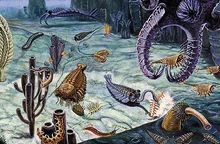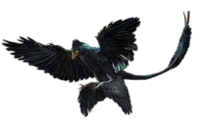
Burgess Shale in 1990
The Burgess Shale is a Cambrian aged fossil formation located in Canada. Known genera include: Anomalocaris, Ottoia, Canadia and Micromitra. The Burgess Shale had shale cliffs around. A cliff collapsed, burying all the specimens. Only some of the species survived.
Palaeofauna[]

A reconstruction of the Burgess Shale as it was during the Cambrian Period
- Anomalocaris and Hallucigenia were first found in the Burgess Shale, but older specimens have been found in the Chengjiang fauna. They are now regarded as lobopods, and Anomalocaris is very similar to Opabinia in most respects (except the eyes and feeding mechanisms)
- Odontogriphus is currently regarded as either a mollusc or a lophotrochozoan, i.e. fairly closely related to the ancestors of molluscs.
-->
| Notable Burgess Shale fossils | |||||||||||
|---|---|---|---|---|---|---|---|---|---|---|---|
| Genus | Phylum | Class | Abundance | Notes | Images | ||||||
|
Panarthropoda |
Stem group? |
A lobopod that possessed appendages for walking. Often found associated with sponges, it is possible that it fed on them. |
|||||||||
|
Onychophora |
Stem group |
Found in both the Burgess Shale and in China |
An armoured lobopod that was originally reconstructed upside-down. Material from China now shows that the original interpretation of "legs" are actually spines. |
||||||||
|
Annelida |
Polychaeta |
A bristle worm that used tentacles to feel for food. It had 24 segments, each carrying a pair of appendages used for propulsion. |
|||||||||
|
Primitive |
over 15000 specimens |
Most common Burgess Shale fauna. Called the Lace Crab by Walcott, it carried a shield extending from its head over its gills. The brush-like appendages of its head probably swept food into its mouth. |
|||||||||
|
Unassigned |
4000 specimens from the Burgess Shale |
A relative of modern-day shrimp, most Canadaspis specimens preserve only its distinctive carapace. Using its legs, Canadaspis brushed off mud to find food. |
|||||||||
|
Unassigned |
An arthropod that had an elongated body with the front covered by a hard carapace. The armour less abdomen possessed no legs, and at the end held a forked tail. Unlike Canadaspis, the legs of Waptia had separate proposes. Waptia was a forager, moving along the ocean floor. |
||||||||||
|
Unassigned |
Related to arachnomorphs, Burgessia had a delicate structure below its round carapace. It is less than 2 cm (0.79 in) long. |
||||||||||
|
Unassigned |
Leanchoilia is distinguished from other arthropods by its arms. They split into three appendages, probably to find food, as they lack the spiny characteristic of predators. |
||||||||||
|
Related to today's, horseshoe crab, Sanctacaris was only first described in 1981. It possessed a large flat tail, suggesting it was a good swimmer, a group of six appendages in each side of its body, and a very streamlined head. |
Unassigned |
Sidneyia was a large 13 centimetres (5.1 in) long predator of the Burgess Shale, and ate trilobites, ostracods, and hyolithids. It was named after Walcott's second son, Sidney. |
|||||||||
|
Yohoia |
Unassigned |
Yohoia was streamlined, and around 2000, it was compared to modern mantis shrimp. In had two four-fingered hands, and may have preyed on trilobites, smashing or spearing them with its fingers. |
|||||||||
|
Mollusca |
Stem-group |
Similar in appearance to a leaf-plated slug, Wiwaxia is a possible bristle worm, although its classification is controversial. Its diet likely constituted of organic detritus. |
|||||||||
|
Dinocaridida |
Opabinia is a strange Burgess Shale taxon; it had five stalked eyes and one appendage with a grasping claw. It may have both swum and walked along the sea floor. |
||||||||||
|
A rare creature |
Nectocaris is rarely preserved, and was probably a swimmer based on the streamlined body. |
||||||||||
|
Primitive |
Probably descended from an even earlier chordate based on fossil material from China, Pikaia swam through the Cambrian like a modern fish. Originally thought to be the most primitive chordate, it had two lobe-like appendages on its head unlike vertebrates. |
||||||||||
|
Dinocaridida |
Resembling a headless shrimp, Anomalocaris was up to 50 centimetres (20 in) long. It was the apex predator of the Burgess Fauna, and trilobite remains preserve bite marks that may come from it. When described, only the lower jaws were known, and the mouth was named separately as the jellyfish Peytoia. Like its relatives, Anomalocaris possessed eye stalks. |
||||||||||

